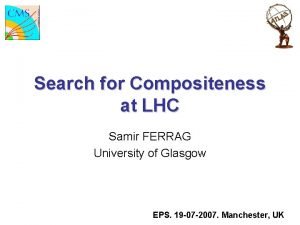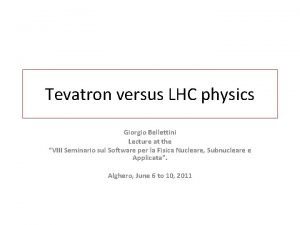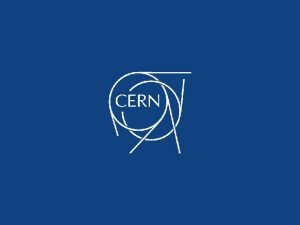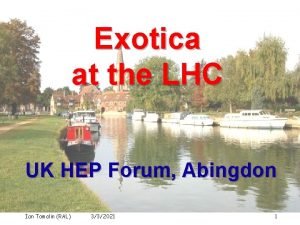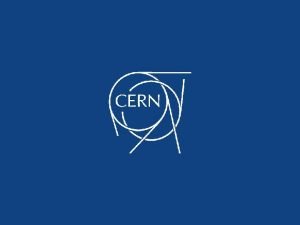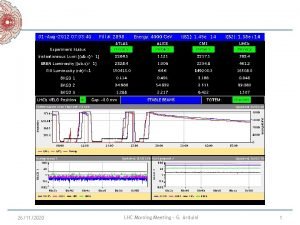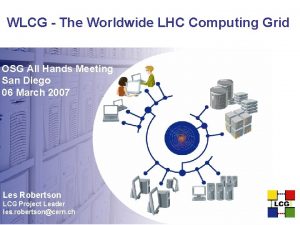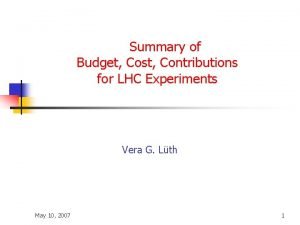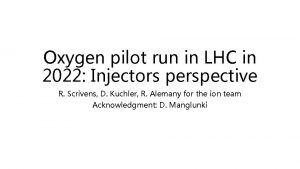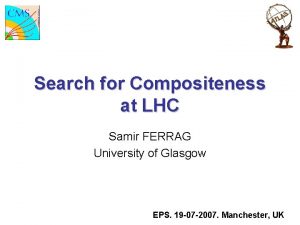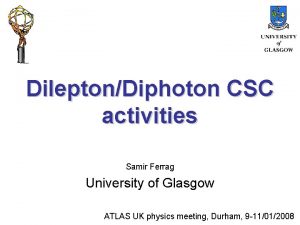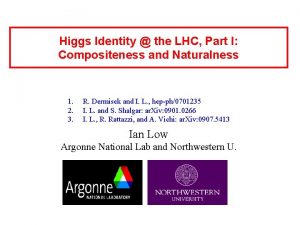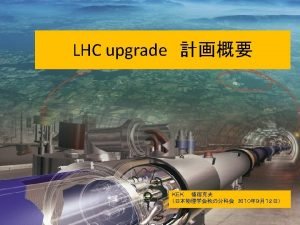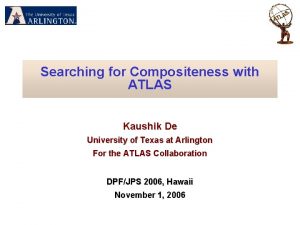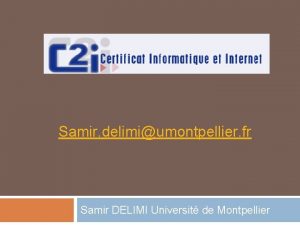Search for Compositeness at LHC Samir FERRAG University









- Slides: 9

Search for Compositeness at LHC Samir FERRAG University of Glasgow EPS. 19 -07 -2007. Manchester, UK

Introduction • History of particle physics is filled with discovery of sub-structures: – Search for quark/lepton substructure: • Jets: Invariant mass, Inclusive jets X-sec, Angular distribution • Dileptons: invariant mass • Compositeness searches include also composite particles, not just sub-structures: – Leptoquarks lepton(s) + jet(s) – Excited quarks q+g or q+V, V=W or Z – Excited leptons: e*, m* and n*

Compositeness at LHC • Quark substructure is described by a (too) generic fourfermion contact interaction: , Q<< – (Te. V): scale, η: interference sign, g 2 = 4. Tevatron: ~ 2 Te. V • Investigated Compositeness physics: – Jets: • Inclusive jet production cross-section d /dp. T: excess of events above standard QCD p. T spectrum. Sensitive to PDF uncertainties and Calorimeter linearity • Dijet angular distribution. excess of events with small pseudorapidity. Smaller systematic uncertainties – Dimuons: • Normalised invariant mass spectrum (Double ratio). – Composite particles: leptoquarks, excited quarks/leptons.

Inclusive jet X-sec ET 0 20 fb-1 • Characterise the excess zone: 3 Te. V 5 Te. V 10 Te. V 20 Te. V 40 Te. V QCD • Sensitivity: 3 Te. V 5 Te. V =3, 5, 10 Te. V might be ruled out or verified with first tens of pb-1 of good data. 20 fb-1 10 Te. V 20 Te. V 40 Te. V Pr AT el L im AS in ar y • Contact term produces more hard scatters than QCD excess at high mass

30 fb-1 3 Te. V Pr AT el L im AS in ar y Systematics in jet X-sec 5 Te. V 10 Te. V 15 Te. V =10 Te. V, L=30 fb-1 20 Te. V error PDFs QCD +1, 2, 3% QCD central value QCD -1, 2, 3% • 1% uncertainty in Energy Scale is enough to hide Λ = 20 Te. V. • Results from PDF uncertainties are not final yet.

Angular distribution of jets p. T > 1 Te. V Pr AT el L im AS in ar y Mjj > 4 Te. V 20 fb-1 3 5 10 20 Te. V 40 Te. V QCD - Two leading jets with 1, 2 : - To characterise the distributions - Sensitivity: (Te. V) L (fb-1) 3 5 10 20 40 < 0. 001 0. 006 0. 7 34 426 • Angular distribution for a high invariant mass bin (excess zone) • Less sensitive to Calorimeter non linearity • = 3, 5, 10 Te. V might be ruled out or verified with first tens of pb-1 of good data. • Systematic effects not yet concluded

Simple angular distribution • Rather than computing the angular distribution for high mass bin the ratio of dijet events, function of invariant mass is used: • Cone algorithm R=0. 5 • Two leading jets with | |<1 • Systematics: relative Jet energy scale at 2 -5% (0. 3 -6. 5 Te. V), jet energy resolution at < 3% and PDFs at 3% (3. 5 Te. V)

Excess in dimuon mass • To minimise sensitivity to luminosity and K-factors two ratios are defined: Normalised invariant mass: and Double Ratio – 0. e 0 number of events in the bin 200 -500 Ge. V (mass range well measured by Tevatron and less PDF systematics) • Systematic effects from: muon efficiency, energy scale, PDFs and radiative corrections are respectively equal to, 2%, 1. 4%, ~5 -10% and 4 -5% • Combined uncertainties: 2. 5% experimental and 11% theory (mature detector)

Conclusion • Contact interactions are generally observed before any exchanged particle are directly seen • Many techniques have been developed and showed good results with low systematic effects: – Double ratio (dimuons) – Angular and simple angular distributions (jets) • Sensitivity of LHC experiments to contact interactions have been investigated and found to be ~few Te. V with only 100 fb-1 • Next step: In case of contact interaction, need to disentangle the underlying physics, Compositeness or something else ?
